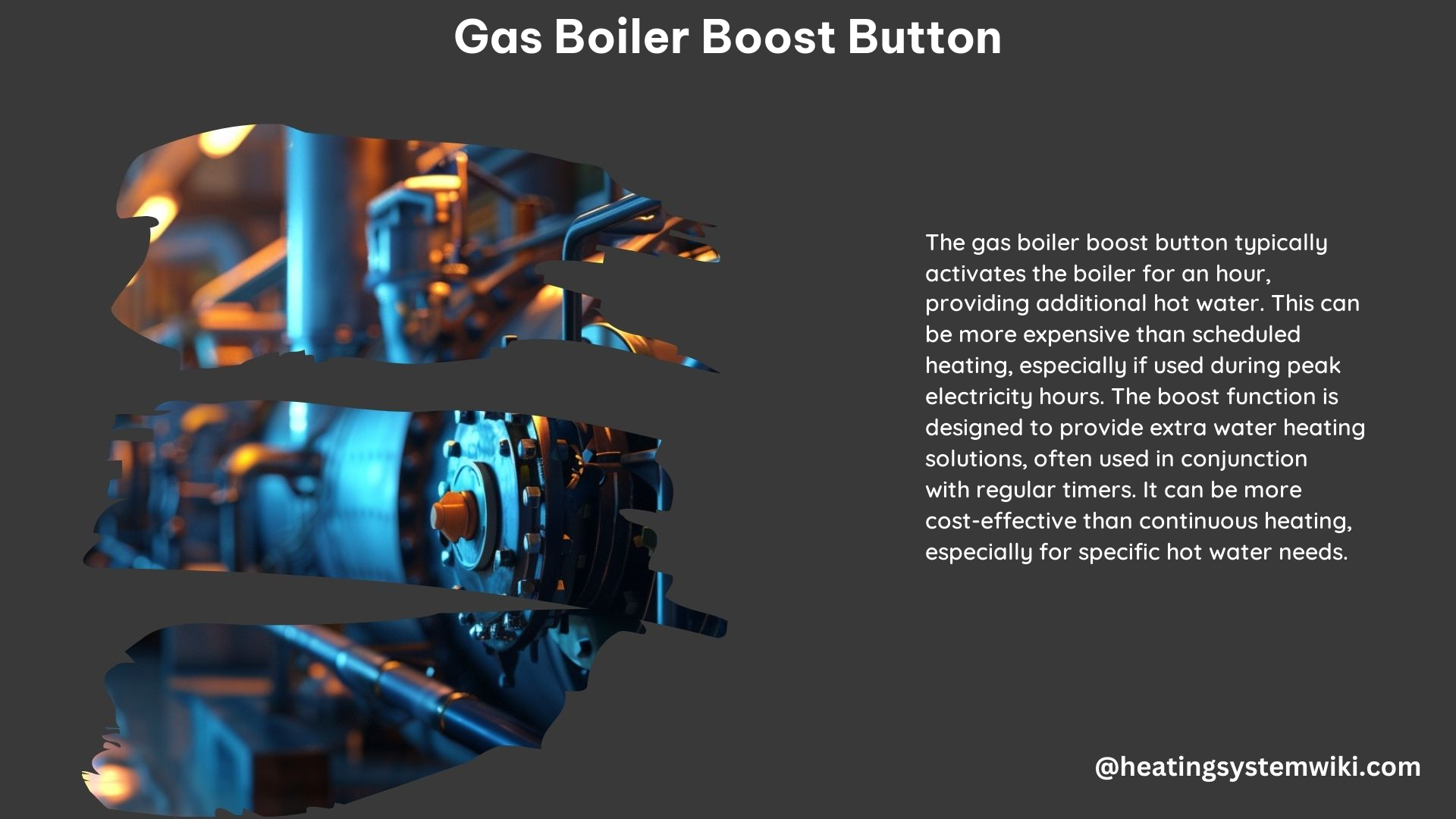The gas boiler boost button is a feature designed to provide additional water heating solutions, allowing users to get a bit of extra heat when needed. This comprehensive guide delves into the technical details of how the boost button works, its purpose, and the impact it has on gas consumption, providing you with a thorough understanding of this valuable feature.
How Does the Gas Boiler Boost Button Work?
Boost Function
The boost button is typically connected to the upper immersion heater in a dual-element system. When pressed, it turns on the upper immersion heater, which heats the top part of the cylinder more quickly than the lower element due to the principle of heat rising. This targeted heating of the upper portion of the cylinder can provide a faster and more efficient way to get extra hot water when needed.
Operation
The boost function can be used in conjunction with the regular water heater timer or instead of it. It is designed to provide extra heat when needed, especially for homes with significant hot water demands. The boost button typically turns on the boiler for a set period, usually one hour, to deliver the additional heating.
The control mechanism for the boost button is often part of the electrical controls and is connected to the upper immersion heater. This allows the user to easily activate the boost function when required, without having to adjust the main heating schedule.
What is the Purpose of the Boost Button on a Gas Boiler?

Additional Heating
The primary purpose of the boost button is to provide additional water heating solutions. By turning on the upper immersion heater, it can quickly heat the top portion of the cylinder, delivering extra hot water when needed. This can be particularly useful in households with high hot water demands, such as during peak usage times or when multiple showers or appliances are running simultaneously.
Energy Efficiency
Using the boost button instead of keeping the unvented cylinder heating throughout the day and night can provide financial and energy savings. By only activating the boost function when necessary, rather than maintaining constant heating, homeowners can reduce their overall gas consumption and lower their energy bills.
How Does the Boost Button Affect Gas Consumption?
Increased Gas Usage
Pressing the boost button turns on the boiler outside of reserved times, which means you pay for an hour of gas to heat the water whenever you press the button. The amount of gas consumed will depend on the size of the cylinder, the temperature difference between the incoming cold water and the desired hot water temperature, and the efficiency of the boiler and heating system.
Cost Considerations
The cost of using the boost button depends on the timing and duration of its use. If used during the day, when gas prices are typically higher, it may cost more than heating water during off-peak hours, such as overnight. Homeowners should consider the timing and frequency of boost button usage to optimize their energy savings.
Technical Specification of Gas Boiler Boost Button
Typical Operation
The boost button typically turns on the boiler for a set period, usually one hour, to provide extra heat when needed. This duration can vary depending on the specific make and model of the boiler, as well as the size and configuration of the hot water system.
The boost function is designed to heat the top portion of the cylinder more quickly, taking advantage of the principle of heat rising. This targeted heating can be more efficient than heating the entire cylinder, especially in systems with dual-element configurations.
Control Mechanism
The boost button is often part of the electrical controls and is connected to the upper immersion heater. This integration allows the user to easily activate the boost function without having to navigate complex menus or settings.
The boost button may be located on the boiler itself, on a separate control panel, or even on a smart thermostat or app, depending on the specific system and manufacturer. Proper understanding of the control mechanism is crucial for effectively utilizing the boost function.
DIY Considerations
Element Location
The functionality of the boost button depends on the location of the heating elements in the system. In dual-element systems, where the upper element is designated for the boost function, the button can warm only the top part of the cylinder. Conversely, systems with both elements at the bottom of the tank rely more on the duration of power usage to heat the entire cylinder.
Insulation and Efficiency
Proper insulation of the hot water tank is crucial for maximizing the efficiency of the boost button. Well-insulated tanks retain heat better, reducing the amount of energy required to maintain the desired water temperature. Additionally, efficient heating practices, such as setting the thermostat to the appropriate temperature and minimizing heat loss, can further optimize the performance and cost-effectiveness of the boost button.
References
- https://www.diynot.com/diy/threads/boost-button-is-permanently-on.496836/
- https://forums.moneysavingexpert.com/discussion/5786113/boost-button-permanently-on
- https://www.alliancehomes.org.uk/media/4179/0188-getting-the-most-from-your-gas-central-heating-controls-05-23-005.pdf
- https://easyflow.co.uk/articles/how-does-the-boost-button-work
- https://www.reddit.com/r/ireland/comments/ycpoe2/does_hitting_the_boost_button_cost_more_than/
